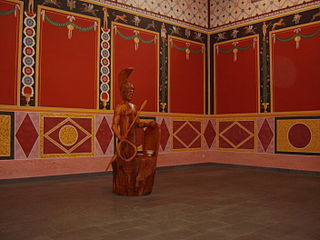
In Gallo-Roman religion, Rosmerta was a goddess of fertility and abundance, her attributes being those of plenty such as the cornucopia. Rosmerta is attested by statues and by inscriptions. In Gaul she was often depicted with the Roman god Mercury as her consort, but is sometimes found independently.
Caturix was the war god of the Helvetii.
Alisanos was a local Gallo-Roman god worshipped in what is now the Côte-d'Or in Burgundy and at Aix-en-Provence.
Anextiomarus is a Celtic epithet of the sun-god Apollo recorded in a Romano-British inscription from South Shields, England. A variant form, Anextlomarus, appears as a divine style or name attested in a fragmentary Gallo-Roman dedication from Le Mans, France. Anextlomarus is also attested as a Gaulish man's father's name at Langres, and a feminine divine form, Anextlomara, appears in two other Gallo-Roman dedications from Avenches, Switzerland.
In Gallo-Roman religion, Arduinna was the eponymous tutelary goddess of the Ardennes Forest and region, thought to be represented as a huntress riding a boar. Her cult originated in the Ardennes region of present-day Belgium, Luxembourg, and France. She was identified with the Roman goddess Diana.
Artio is a Celtic bear goddess. Evidence of her worship has notably been found at Bern in Switzerland. Her name is derived from the Gaulish word for 'bear', artos.
Belisama is a Gallo-Roman goddess. She was identified by Roman commentators with Minerva by interpretatio romana. The name also appears in various river names of Gauls and Britain, including Belisama and Le Blima (Tarn).

In Gallo-Roman religion, Loucetios was a Gallic god known from the Rhine-Moselle region, where he was identified with the Roman Mars. Scholars have interpreted his name to mean ‘lightning’. Mars Loucetius was worshipped alongside the goddess Nemetona.

In Celtic mythology, Nantosuelta is the goddess of nature, the earth, fire and fertility.
Icovellauna was a Celtic goddess worshiped in Gaul. Her places of worship included an octagonal temple at Le Sablon in Metz, originally built over a spring, from which five inscriptions dedicated to her have been recovered, and Trier, where Icovellauna was honored in an inscription in the Altbachtal temple complex. Both of these places lie in the valley of the river Moselle of eastern Gaul in what are now Lorraine in France and Rhineland-Palatinate in Germany. One such inscription was, somewhat unusually, inscribed on a copper tablet in Roman cursive letters.

Lenus was a Celtic healing god worshipped mainly in eastern Gaul, where he was almost always identified with the Roman god Mars. He was an important god of the Treveri tribe, who had large sanctuaries at medicinal springs at Trier and the Martberg by Pommern in what is now Germany. Two dedications to him are also known from southwestern Britain. Edith Wightman characterizes him as “one of the best examples of a Teutates, or god of the people, equated with Mars—protector of the tribe in battle, but also [...] bestower of health and general good fortune” (p. 211). His sanctuary ‘Am Irminenwingert’ at Trier had a large temple, baths, smaller shrines and a theatre; that on the Martberg also included a large variety of buildings, probably including rooms for health-seeking pilgrims to stay. Despite his associations with healing, Lenus Mars is depicted classically as a warrior with Corinthian helmet in a bronze statuette from the Martberg.

Intarabus was a Gaulish god in the pantheon of the Treveri and some neighbouring peoples. His name is known from nine inscriptions from a relatively compact area in what are now Belgium, Luxembourg, western Germany and eastern France. He may have been the tutelary deity of one of the three pagi (subdivisions) of the Treveri. In most cases, Intarabus is invoked alone – without any synthesis to a Roman deity, and without accompanying female deities. However, one inscription invokes him as Mars Intarabus, noting that a fanum and simulacrum of this god had been restored at Trier. Meanwhile, another inscription from Mackwiller in Alsace gives Intarabus the epithet Narius. An inscription at Ernzen in Germany has his name as [In]tarabus, while another from Foy-Noville, invokes Entarabus in conjunction with the Genius Ollodagus.
The Latobici or Latovici were a Celtic tribe dwelling in Pannonia Superior, around present-day Drnovo (Slovenia), during the Roman period.
The Chamalières tablet is a lead tablet, six by four centimeters, that was discovered in 1971 in Chamalières, France, at the Source des Roches excavation. The tablet is dated somewhere between 50 BC and 50 AD. The text is written in the Gaulish language, with cursive Latin letters. With 396 letters grouped in 47 words, it is the third-longest extant text in Gaulish, giving it great importance in the study of this language. The magical subject matter of the text, which invokes the Celtic deity Maponos, suggests it should be considered a defixiones tablet.

The Lezoux plate is a ceramic plate discovered in 1970 at Lezoux (Puy-de-Dôme), which contains one of the longer texts in the Gaulish language which has yet been found.
Pierre-Yves Lambert is a French linguist and scholar of Celtic studies. He is a researcher at the CNRS and a lecturer at the École Pratique des Hautes Études in Celtic linguistics and philology. Lambert is the director of the journal Études Celtiques.
Xavier Delamarre is a French linguist, lexicographer, and diplomat. He is regarded as one of the world's foremost authorities on the Gaulish language.
The Iemerii were a Celto-Ligurian tribe dwelling in the Val Chisone during the Iron Age.
The Benacenses were a Gallic tribe dwelling west of Lake Garda during the Roman period.
![One of the two Latin altars dedicated to Anvallus. The inscription may be interpreted as "Consecrated to the august, to the god Anvallus, Norbaneius Thallus the gutuater [freely and deservedly fulfilled his vow]". Anvallus MuseeRolin Autun 2600.jpg](http://upload.wikimedia.org/wikipedia/commons/thumb/8/82/Anvallus_MuseeRolin_Autun_2600.jpg/330px-Anvallus_MuseeRolin_Autun_2600.jpg)







